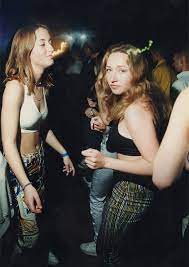FASHION
90s Rave Fashion: A Colorful Journey Through Subculture and Style

90s Rave Fashion among these, the rave culture arose as a pulsing cultural phenomenon, offering a distinct and unconventional dress style that continues to inspire current trends. Dive into the heart of 90s rave fashion and you’ll find a dazzling mix of bright hues, bizarre clothing designs, and a rebellious spirit that defined an era.
Introduction to 90s Rave Fashion
With its origins in the underground music scene, 90s rave culture carved out a distinct area for individuals to express themselves through unorthodox apparel and accessories. This movement became synonymous with young revolt, espousing an attitude of freedom, self-expression, and nonconformity.
Evolution of Rave Culture
The rave culture, which began in the late 1980s in the United Kingdom, quickly expanded across Europe and the United States, bringing with it an avant-garde fashion that mimicked the throbbing rhythms of electronic music. The development of warehouse parties and all-night raves provided a platform for creative self-expression, creating an environment in which dress was as much an art form as music itself.
Signature Fashion Trends of the 90s Rave Scene
The Rise of Neon Colors and Fluorescent Fabrics
Neon colors were synonymous with rave fashion in the 1990s, with apparel embellished in electrifying tints of pink, green, orange, and yellow. Fluorescent textiles, which were frequently lit by black lights, produced an unearthly glow that turned ravers into ethereal figures within the throbbing blackness of the dance floor.
Embracing the ‘Cyberpunk’ Aesthetic
The confluence of futuristic and dystopian aspects gave rise to the ‘cyberpunk’ style, which is distinguished by metallic textiles, futuristic accessories, and an overall edgy and avant-garde look. Clothing and accessories inspired by cyberpunk became a symbol of revolt, questioning traditional conceptions of fashion and beauty.
Iconic Clothing Styles and Accessories
The rave fashion scene of the 1990s included a wide range of clothing designs and accessories that mirrored the spirit of the time.
Baggy Pants and Bright Crop Tops
Baggy, wide-leg trousers coupled with bright, skin-baring crop tops became a rave wardrobe staple. These outfits enabled uninhibited movement on the dance floor while conveying a carefree and energetic attitude.
Platform Shoes and Chunky Sneakers
Platform shoes and chunky sneakers, which were frequently embellished with bright patterns and neon accents, not only increased height but also became a sign of uniqueness and self-expression. Their hefty patterns provided both comfort and flair, making them a popular option for nighttime ravers.
Hair and Makeup Trends of the 90s Rave Culture
Glitter, Glitter, Everywhere!
Ravers embraced glitter like never before, decorating their faces, hair, and bodies with a dazzling assortment of adornments. Glitter became a means of self-expression, allowing people to construct their own distinctive.
Experimenting with Hair Dye and Unique Hairstyles
Hair that was brightly colored and styled in unusual ways was prevalent in rave culture. The 90s rave movement pushed people to experiment recklessly with their hair, from brilliant blues.
Influence of Music on Rave Fashion
Electronic music’s throbbing beats and joyful melodies had a significant impact in establishing rave culture’s dress style in the 1990s. The collaboration of music and fashion enabled the seamless integration of vibrant, unconventional styles that mirrored the energy and rhythm of the music itself.
Mainstream Adoption and Ongoing Influence of 90s Rave Fashion
Electronic music’s throbbing beats and joyful melodies had a significant impact in establishing rave culture’s dress style in the 1990s. The collaboration of music and fashion enabled the seamless integration of vibrant.
Modern Interpretations and Revival of 90s Rave Fashion
Contemporary designers and fashion brands continue to honor the varied and rebellious spirit of rave fashion from the 1990s. The resurgence of neon hues, large shapes. And futuristic aspects in recent fashion shows and collections reflects a revived interest in the vitality and brilliance of this historic era.
Impact of Rave Fashion on Contemporary Trends
Contemporary designers and fashion brands continue to pay respect to the varied and rebellious attitude of 1990s rave fashion. The resurgence of neon hues, large shapes, and futuristic aspects in recent fashion shows and collections reflects a revived interest in the vibrancy and vitality of this legendary era.
Sustainability and 90s Rave Fashion: A Modern Perspective
As the fashion industry grapples with sustainability issues, the ideas of 90s rave fashion have sparked discussions. The focus on DIY fashion, upcycling, and reusing is consistent with the
idea of sustainability, creating a more mindful approach to fashion that pays respect to the essence of 90s rave culture.
The Enduring Legacy of 90s Rave Fashion
idea of sustainability, creating a more mindful approach to fashion that pays respect to the essence of 90s rave culture
FAQs
-
Was 90s rave fashion solely about clothing?
- 90s rave fashion was a cultural trend that celebrated freedom, self-expression, and uniqueness via vivid and eccentric outfits.
FASHION
Art and Fashion Colleges in Uganda: Cultivating Creativity and Style

Art and Fashion Colleges in Uganda: Cultivating Creativity and Style
Art and Fashion Colleges in Uganda fashion and art have always been closely related, influencing one another constantly via creative exchanges. This synthesis is particularly evident in Uganda, where designers and artists are influenced by the rich cultural legacy of the nation.
Why Choose Uganda for Art and Fashion Studies?
Cultural Richness
Uganda’s many cultures offer a distinctive setting for artistic investigation. With so much inspiration available to them, students may draw inspiration from everything from traditional clothing to modern art forms.
Affordable Education
Uganda offers art and fashion education at a substantially lower cost than many Western countries, which attracts foreign students.
Emerging Market
Emerging designers and artists have a bright future in Uganda because to the country’s expanding economy and increased demand for locally produced goods.
Top Art and Fashion Colleges in Uganda
Kampala School of Design (KSD)
Uganda’s growing economy and rising demand for locally made items bode well for the country’s up-and-coming designers and artists. KSD, which is centrally located in Kampala, provides a variety of fine arts, graphic design, and fashion design programs. The institution is renowned for its links to business and pragmatic approach to teaching.
Margaret Trowell School of Industrial and Fine Arts
Margaret Trowell School is one of Uganda’s oldest and most prestigious art schools, and it is a component of Makerere University. Numerous courses in visual arts, sculpting, and textile design are available.
Uganda Christian University (UCU)
UCU’s Department of Art and Design is committed to nurturing creativity and innovation. With modern facilities and experienced faculty, it’s a hub for aspiring artists and designers.
Mengo Senior School
Mengo Senior School features a robust arts department that enables pupils to experiment with many materials and styles, despite not being a designated art school.
Makerere University School of Fine Art
Makerere University School of Fine Art is an esteemed establishment that has a rich legacy of producing exceptional artists. It provides degree programs in painting, sculpture, and art teaching.
Kyambogo University
The art and design department at Kyambogo University equips students for jobs in both classic and modern art genres by emphasizing practical skills and hands-on experience.
Courses Offered
- Fashion Design: From sketching to garment construction, students learn the ins and outs of creating wearable art.
- Fine Arts: Painting, sculpture, and mixed media techniques are explored, allowing students to develop their artistic voice.
- Textile Design: This course delves into the world of fabrics, patterns, and printing techniques.
- Graphic Design: Combining art and technology, graphic design students learn to communicate visually through digital mediums.
Facilities and Resources
Ugandan art and fashion schools are equipped with state-of-the-art facilities to encourage students’ artistic pursuits. Modern studios, well furnished workshops, and sizable libraries offer a supportive study environment.
Student Life
Students can engage in a variety of groups and organizations devoted to art and fashion outside of the classroom. These extracurricular activities provide an opportunity to network and display one’s abilities.
Career Prospects
Graduates from fashion and art schools in Uganda work in an industry that is both lucrative and competitive. The opportunities are endless, ranging from starting their own fashion labels to serving as art directors for well-known companies.
Challenges and Opportunities
Although Uganda’s creative sector is flourishing, there are still obstacles to overcome, such a lack of finance and market accessibility. Nonetheless, these obstacles also offer chances for creativity and business ventures.
Inspirational Success Stories
Successful alumni’s biographies inspire present students. These tales, which range from well-known artists to up-and-coming fashion designers, demonstrate the value of art and fashion education in Uganda.
Future of Art and Fashion in Uganda
The future of fashion and the arts appears bright as long as the nation supports its creative sectors. Uganda is ready to leave its mark on the international creative scene because to institutional backing, government efforts, and a rising awareness for regional talent.
Conclusion
In Uganda, art and fashion universities are essential for developing talent, encouraging innovation, and influencing the industry’s future. For those who want to pursue careers in art and design, these universities provide a comprehensive curriculum together with an active student body.
Frequently Asked Questions (FAQs)
-
Are scholarships available for international students?
- Some institutions offer scholarships based on merit or need. It’s best to check with the specific college for details.
-
Can I study both fashion design and fine arts?
- Yes, many colleges allow students to explore multiple disciplines to broaden their skills.
-
What career paths can I pursue after graduation?
- Graduates can work as fashion designers, art directors, illustrators, textile artists, and more.
-
Is there a market for locally-made fashion in Uganda?
- Yes, with the growing interest in African fashion, there is a thriving market for unique, locally-made designs.
-
How can I apply to these colleges?
- Each college has its own application process. Visit their websites or contact admissions offices for detailed information.
FASHION
Art and Fashion Colleges in Uganda

Art and Fashion Colleges in Uganda fashion and art have long been important social constructs that represent personal expression and cultural identity. There has been a noticeable increase in demand for creative education in Uganda in recent years. With the country’s embracing of its rich creative legacy and recognition of the fashion industry’s potential, the construction of art and fashion institutions has become essential to developing talent and encouraging creativity.
Overview of the Education System in Uganda
Prior to digging into the details of art and fashion institutions, it is important to comprehend the educational system in Uganda. Uganda adheres to a system of basic, secondary, and post-secondary education, similar to many other nations. Universities, colleges, and vocational training facilities are all part of tertiary education.
Rise of Art and Fashion Colleges in Uganda
The establishment of fashion and art institutions in Uganda marks a paradigm change in the understanding of the role of the creative industries. This tendency not only meets the increasing need for qualified workers but also makes a major economic contribution to the nation.
Top Art and Fashion Colleges in Uganda
A number of establishments are notable for their dedication to provide top-notch instruction in the domains of art and fashion. The Margaret Trowell School of Industrial and Fine Arts, Uganda Technical College-Lira, and Makerere University School of Industrial and Fine Arts are a few of the best universities.
Courses Offered
These universities provide a broad selection of courses designed to fulfill students’ varied interests and professional goals. Among the many programs offered are those in fashion, textile, graphic, fine arts, and interior design.
Faculty and Facilities
These universities, which are well-known for their cutting-edge facilities and knowledgeable teachers, guarantee that students receive thorough instruction and exposure to industry standards.
Admission Process
A thorough selection procedure is conducted for potential students, which may involve portfolio evaluations, interviews, and verification of academic credentials. Every institution has unique admissions policies and procedures.
Career Opportunities
There are several job options open to Ugandan graduates of art and design institutes. Among other things, they can become fashion designers, painters, illustrators, stylists, and teachers.
Challenges Faced
Even with the advancements, Uganda’s art and fashion schools continue to confront obstacles including poor facilities, low financing, and a lack of understanding of the value of creative education.
Success Stories
Numerous former students of these universities have had a major impact on Uganda’s fashion and art scenes on a national and worldwide level. Both present and future students can draw inspiration from their success stories.
Impact on Ugandan Society
Beyond aesthetics, art and fashion have a significant impact on Ugandan culture, helping to shape cultural identity, encourage social change, and promote innovation.
Future Prospects
Uganda’s art and fashion education industry has enormous growth and development potential with sustained support and investment. In the upcoming years, the sector should see even more advancements.
Testimonials
“My time as a student at an art and fashion college in Uganda has been life-changing. My education and abilities have prepared me for a lucrative job in the creative sector.” – Sarah K., student of fashion design
“My college’s instructors are enthusiastic about fostering talent and helping students reach their greatest potential. I appreciate all of the guidance and assistance I’ve had along the way. David M., a student of fine arts
Conclusion
In Uganda, art and fashion institutions are essential for developing talent, encouraging creativity, and advancing the country’s economy. These institutions are influencing the direction Uganda’s creative industries will take by offering high-quality education and encouraging a creative culture.
FAQs
-
Are art and fashion colleges in Uganda accredited?
- Yes, most colleges are accredited by the relevant authorities in Uganda.
-
What career opportunities are available to graduates?
- Graduates can pursue careers in fashion design, graphic design, fine arts, textile design, and more.
-
How long do programs typically last?
- Program durations vary, but most undergraduate programs last between three to four years.
-
Are scholarships available for students?
- Some colleges offer scholarships and financial aid to deserving students.
-
What sets Ugandan art and fashion colleges apart from others?
- Ugandan colleges offer a unique blend of traditional craftsmanship and contemporary design, reflecting the country’s rich cultural heritage.
FASHION
Ethereal Flames: The Enchanting World of Radiant Cut Diamond Rings

Radiant cut diamonds, with their mesmerizing brilliance and unique faceting, stand as true testaments to the artistry and craftsmanship within the realm of fine jewelry. In this exploration, we delve into the ethereal flames that ignite from the facets of radiant cut diamond rings, transcending them beyond mere adornments into captivating symbols of everlasting love and elegance.
The Unparalleled Brilliance of Radiant Cuts
Radiant cut diamonds are renowned for their exceptional brilliance, a result of their distinctive faceting style. These diamonds blend the elegance of step-cut designs with the fiery brilliance of brilliant-cut diamonds. The result? A scintillating play of light that dances through the facets, casting a radiant glow that captures hearts and mesmerizes onlookers.
Craftsmanship Unveiled: Mastering the Art of Radiant Cuts
Crafting a radiant cut diamond requires the expertise of skilled artisans who meticulously shape and polish each facet to perfection. The precision in cutting is paramount, ensuring that the diamond achieves optimal symmetry and alignment, unleashing its full potential for brilliance. It is in the hands of these artisans that the ethereal flames of radiant cut diamonds are forged.
Unraveling the Allure: Why Choose Radiant Cut Diamond Rings
Timeless Elegance Meets Contemporary Flair
Radiant Cut Engagement Rings strike the perfect balance between timeless elegance and contemporary flair. The square or rectangular shape, coupled with trimmed corners, lends a modern touch, making them ideal for those seeking a harmonious blend of classic and contemporary styles. It’s a choice that transcends fleeting trends, ensuring a timeless allure that withstands the test of time.
Versatility Redefined: From Engagement to Everyday Glamour
The versatility of radiant cut diamond rings knows no bounds. While these diamonds make a stunning statement in engagement rings, their adaptability extends to various jewelry styles. Whether adorning a pendant, earrings, or a luxurious bracelet, the ethereal flames of radiant cuts add a touch of sophistication to any ensemble, elevating everyday glamour to extraordinary heights.
Choosing Radiant Cut Diamond Rings: A Buyer’s Guide
When venturing into the world of radiant cut diamond rings, understanding the 4 Cs is crucial. Clarity reveals the purity of the diamond, Cut determines its brilliance, Color enhances its aesthetic, and Carat Weight speaks to its size. Together, these factors harmonize to create a radiant cut diamond that embodies perfection, reflecting the ethereal flames that define its allure.
Setting the Stage: Choosing the Perfect Setting
The setting of a radiant cut diamond plays a pivotal role in enhancing its beauty. Opting for a prong setting allows maximum light exposure, amplifying the ethereal flames. Alternatively, a halo setting can add an extra layer of brilliance, framing the radiant cut with smaller diamonds for an enchanting effect. The choice of setting is a personalized touch that accentuates the unique qualities of each radiant cut diamond.
Ethereal Flames in the Spotlight: Celebrities and Radiant Cut Diamond Rings
Red Carpet Glamour: A-Listers and Radiant Cuts
Celebrities have long been drawn to the allure of radiant cut diamond rings. From Hollywood’s red carpets to glamorous events, A-listers showcase the timeless elegance and modern sophistication of these diamonds. Their choice further propels the radiant cut into the limelight, solidifying its status as a symbol of luxury and style.
Conclusion
the world of radiant cut diamond rings is a captivating journey into the heart of brilliance and sophistication. From the craftsmanship that shapes these diamonds to the versatile elegance they exude, radiant cuts stand as a beacon of enduring love and refined taste. Choosing a radiant cut diamond is not just a purchase; it’s an investment in timeless beauty that transcends generations.


